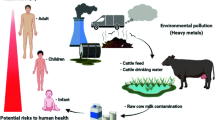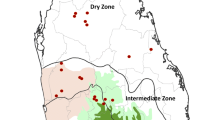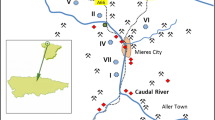Abstract
The object of this study is to analyze the levels of seven toxic elements residues in raw bovine milk in China and assess the potential health risk of those residues. The 178 raw bovine milk samples were collected from eight main milk-producing provinces and from three types of milk stations in China, and were analyzed for arsenic (As), lead (Pb), cadmium (Cd), chromium (Cr), mercury (Hg), aluminum (Al), and nickel (Ni) using inductively coupled plasma-mass spectrometry (ICP-MS). Al, Pb, Hg, Ni, Cr, and As were detected in 47.8, 29.2, 28.1, 23.6, 12.4, and 9.0% of total milk samples, respectively, and Cd were not detected in all samples. The raw bovine milk samples with high levels of toxic elements were found in industrial areas, such as Heilongjiang and Shanxi. Nemerow pollution index analysis showed that the levels were lower in the samples from the processing plants than that from the large-scale farms and small farm cooperatives. The margin of exposure (MOE) values suggest that the levels of As, Pb, Hg, Cr, Al, and Ni in the raw milk samples are not causing a health risk for Chinese consumers, including adults and children. Nevertheless, the risk of Pb for infant and young children was more serious than adult.

Similar content being viewed by others
References
Licata P, Trombetta D, Cristani M, Giofrè F, Martino D, Calò M, Naccari F (2004) Levels of “toxic” and “essential” metals in samples of bovine milk from various dairy farms in Calabria, Italy. Environ Int 30(1):1–6. doi:10.1016/s0160-4120(03)00139-9
Oliver MA (1997) Soil and human health: a review. Eumpean Journal of Soil Science 48:573–592
Chen C, Mi X, Yuan Y, Chen G, Ren L, Wang K, Zhu D, Qian Y (2014) A preliminary risk assessment of potential exposure to naturally occurring estrogens from Beijing (China) market milk products. Food Chem Toxicol 71:74–80. doi:10.1016/j.fct.2014.05.028
Kazi TG, Jalbani N, Baig JA, Kandhro GA, Afridi HI, Arain MB, Jamali MK, Shah AQ (2009) Assessment of toxic metals in raw and processed milk samples using electrothermal atomic absorption spectrophotometer. Food Chem Toxicol 47(9):2163–2169. doi:10.1016/j.fct.2009.05.035
D'Ilio S, Petrucci F, D'Amato M, Di Gregorio M, Senofonte O, Violante N (2008) Method validation for determination of arsenic, cadmium, chromium, and lead in milk by means of dynamic reaction cell inductively coupled plasma mass spectrometry. Anal Chim Acta 624(1):59–67. doi:10.1016/j.aca.2008.06.024
Kottferova J, Korenekova B (1995) The effect of emission of heavy metals concentrations in cattle from the area of an industrial plant in Slovakia. Arch Environ Contam Toxicol 29:400–405
Lanphear BP, Hornung R, Khoury J, Yolton K, Baghurst P, Bellinger DC, Canfield RL, Dietrich KN, Bornschein R, Greene T, Rothenberg SJ, Needleman HL, Schnaas L, Wasserman G, Graziano J, Roberts R (2005) Low-level environmental lead exposure and children’s intellectual function: an international pooled analysis. Environ Health Perspect 113(7):894–899. doi:10.1289/ehp.7688
Potortì AG, Di Bella G, Lo Turco V, Rando R, Dugo G (2013) Non-toxic and potentially toxic elements in Italian donkey milk by ICP-MS and multivariate analysis. J Food Compos Anal 31(1):161–172. doi:10.1016/j.jfca.2013.05.006
Commission Regulation (EC) (2006) Setting maximum levels for certain contaminants in food stuffs. No 1881/2006 of 19 December 2006
Ministry of Health of the People’s Republic of China (MOH) (2012) Maximum levels of contamination in foods. GB 2762–2012
Codex Alimentarius Commission (CAC) (1995) Codex general standard for contaminations and toxins in food and feed. Codex-Standard-193-1995
Caggiano R, Sabia S, D'Emilio M, Macchiato M, Anastasio A, Ragosta M, Paino S (2005) Metal levels in fodder, milk, dairy products, and tissues sampled in ovine farms of southern Italy. Environ Res 99(1):48–57. doi:10.1016/j.envres.2004.11.002
Khan N, Jeong IS, Hwang IM, Kim JS, Choi SH, Nho EY, Choi JY, Park KS, Kim KS (2014) Analysis of minor and trace elements in milk and yogurts by inductively coupled plasma-mass spectrometry (ICP-MS). Food Chem 147:220–224. doi:10.1016/j.foodchem.2013.09.147
Patra RC, Swarup D, Kumar P, Nandi D, Naresh R, Ali SL (2008) Milk trace elements in lactating cows environmentally exposed to higher level of lead and cadmium around different industrial units. Sci Total Environ 404(1):36–43. doi:10.1016/j.scitotenv.2008.06.010
Simsek O, Gultekin R, Oksuz O, Kurultay S (2000) The effect of environmental pollution on the heavy metal content of raw milk. Mol Nutr Food Res 44:360–371
Tajkarimi M, Ahmadi Faghih M, Poursoltani H, Salah Nejad A, Motallebi AA, Mahdavi H (2008) Lead residue levels in raw milk from different regions of Iran. Food Control 19(5):495–498. doi:10.1016/j.foodcont.2007.05.015
Qu XY, Zheng N, Wang JQ, Xu XM, Han RW, Zhen YP, Li SL (2013) Survey of heavy metal residues in raw milk in Tangshan City of China. J Food Agric Environ 11:259–262
Sola-Larrañaga C, Navarro-Blasco I (2009) Chemometric analysis of minerals and trace elements in raw cow milk from the community of Navarra, Spain. Food Chem 112(1):189–196. doi:10.1016/j.foodchem.2008.05.062
Boobis AR, Ossendorp BC, Banasiak U, Hamey PY, Sebestyen I, Moretto A (2008) Cumulative risk assessment of pesticide residues in food. Toxicol Lett 180(2):137–150. doi:10.1016/j.toxlet.2008.06.004
European Food Safety Authority (EFSA) (2005). Opinion of the scientific committee on a request from EFSA related to a harmonised approach for risk assessment of substances which are both genotoxic and carcinogenic. EFSA Journal
Benford D, Bolger PM, Carthew P, Coulet M, DiNovi M, Leblanc JC, Renwick AG, Setzer W, Schlatter J, Smith B, Slob W, Williams G, Wildemann T (2010) Application of the margin of exposure (MOE) approach to substances in food that are genotoxic and carcinogenic. Food Chem Toxicol 48(Suppl 1):S2–24. doi:10.1016/j.fct.2009.11.003
WHO/IPCS (2009) Principles for modelling dose-response for the risk assessment of chemicals
European Food Safety Authority (EFSA) (2014). Dietary exposure to inorganic arsenic in the European population. EFSA J 12
European Food Safety Authority (EFSA) (2009) Scientific opinion on arsenic in food. EFSA J 7:1351
European Food Safety Authority (EFSA) (2014). Scientific Opinion on the risks to public health related to the presence of chromium in food and drinking water. EFSA J 12
European Food Safety Authority (EFSA) (2010) Scientific opinion on lead in food. EFSA J 8:1570
European Food Safety Authority (EFSA) (2012) Scientific opinion on the risk for public health related to the presence of mercury and methylmercury in food. EFSA J 10:2985
European Food Safety Authority (EFSA) (2015) Scientific Opinion on the risks to public health related to the presence of nickel in food and drinking water. EFSA J 13
European Food Safety Authority (EFSA) (2008) Scientific opinion of the panel on food additives, Flavourings, processing aids and food contact materials (AFC). EFSA J 754:1–34
United States Environmental Protection Agency (EPA) (2002) Child-specific exposure factors handbook
Chinese Society of Nutrition (2011) Chinese dietary guidelines
World Health Organization (WHO) (2006) Length height-for-age, weight-for-age, weight-for-length, weight-for-height and body mass index-for-age Methods and development
World Health Organization (WHO) (2011) Guidelines for drinking-water quality
Agency for Toxic Substances (ATSDR) (2016) ATSDR minimum risk levels (MRLs)
Ministry of Health of the People’s Republic of China (MOH) (2008) Criterion in quality control of laboratories-chemical testing of food. GB/T 27404–2008
Bilandžić N, Đokić M, Sedak M, Solomun B, Varenina I, Knežević Z, Benić M (2011) Trace element levels in raw milk from northern and southern regions of Croatia. Food Chem 127(1):63–66. doi:10.1016/j.foodchem.2010.12.084
Vidovic M, Sadibasic A, Cupic S, Lausevic M (2005) Cd and Zn in atmospheric deposit, soil, wheat, and milk. Environ Res 97(1):26–31. doi:10.1016/j.envres.2004.05.008
Herwig N, Stephan K, Panne U, Pritzkow W, Vogl J (2011) Multi-element screening in milk and feed by SF-ICP-MS. Food Chem 124(3):1223–1230. doi:10.1016/j.foodchem.2010.07.050
Liu ZP (2003) Lead poisoning combined with cadmium in sheep and horses in the vicinity of non-ferrous metal smelters. Sci Total Environ 309(1–3):117–126. doi:10.1016/s0048-9697(03)00011-1
Rey-Crespo F, Miranda M, Lopez-Alonso M (2013) Essential trace and toxic element concentrations in organic and conventional milk in NW Spain. Food Chem Toxicol 55:513–518. doi:10.1016/j.fct.2013.01.040
Liu WH, Zhao JZ, Ouyang ZY, Soderlund L, Liu GH (2005) Impacts of sewage irrigation on heavy metal distribution and contamination in Beijing, China. Environ Int 31(6):805–812. doi:10.1016/j.envint.2005.05.042
Yu QL (2004) Hazard analysis and safety system on the food chain of environment-forage-yak meat/milk products in Tianzhu. Gansu Agriculture University,
Zheng N, Wang JQ, Han RW, Zhen YP, Xu XM, Sun P (2013) Survey of aflatoxin M1 in raw milk in the five provinces of China. Food Addit Contam: Part B 6(2):110–115. doi:10.1080/19393210.2012.763191
Acknowledgements
This study was supported by special fund for agro-scientific research in the public interest (201403071), The Agriculture Science and Technology Innovation Program (ASTIP-IAS12).
Author information
Authors and Affiliations
Corresponding author
Rights and permissions
About this article
Cite this article
Qu, XY., Zheng, N., Zhou, XW. et al. Analysis and Risk Assessment of Seven Toxic Element Residues in Raw Bovine Milk in China. Biol Trace Elem Res 183, 92–101 (2018). https://doi.org/10.1007/s12011-017-1116-x
Received:
Accepted:
Published:
Issue Date:
DOI: https://doi.org/10.1007/s12011-017-1116-x




